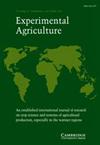Canopy development, leaf traits and yield in high-altitude Andean maize under contrasting plant densities in Argentina
IF 1.9
4区 农林科学
Q1 Agricultural and Biological Sciences
引用次数: 0
Abstract
Summary In highlands, the increase in altitude results in a drastic decrease in temperature (T) that delays phenological development of maize, decreasing light interception during the cycle. This could be partially overcome by increasing plant density, but information is scarce for designing specific management options. The objective of this work was to describe changes in canopy development, photosynthetic performance, biomass and yield of maize grown at contrasting plant densities (5.7 plants m −2 , locally used, and 8.7 plants m −2 , 50% higher). Three experiments were carried out in two high-altitude environments within the Argentinean Andean region, Hornillos (HOR, 2380 masl, 2019–20 and 2020–21) and El Rosal (ERO, 3350 masl, 2019–20), and complementary data were obtained from samplings in 8 farmer’s fields (from 2400 to 3400 masl, 2022–23). In the experiments, mean T during the first 150 days of the cycle was 33% lower at ERO, which implied 39 extra days but 25% shorter thermal time to achieve silking. The higher plant density significantly increased leaf area index and light interception at ERO, whereas at HOR, this was only evident during the second season. At the leaf level, plants grown at ERO had thicker leaves with higher chlorophyll (+36%) and nitrogen (40%) content. Photosynthetic electron transport rate at full irradiance was +20% higher at ERO but significantly varied throughout the day with lowest values in the morning, which was not observed at HOR and was not related to light intensity or stomatal conductance. At HOR, the increase in plant density did not improve light interception, nor yield in 2019–20 (with average yields of 6356 kg ha −1 ) but it did improve both in 2020–21 when generally lower yields were attained (4821 kg ha −1 ). Across farmer’s fields, increasing densities consistently reduced yield per plant ( r 2 = 0.57***) but improved yield per area basis, which was maximised at 10 pl m −2 as a result of a steady increase in kernel number m −2 (up to 15 pl m −2 ). Thus, in these high-altitude environments, increasing plant density beyond recommended (6 pl m −2 ) is a promising approach for improving yield, with major penalties of supra-optimum densities being related to kernel weight. Further work is needed to explore the effect of different factors limiting kernel growth, over plant density responses.不同密度下阿根廷高海拔安第斯玉米的冠层发育、叶片性状和产量
在高原地区,海拔的升高导致温度(T)的急剧下降,延缓了玉米的物候发育,减少了周期中的光截获。这可以通过增加植物密度来部分克服,但是缺乏设计具体管理方案的信息。本研究的目的是描述不同植物密度(5.7株m−2,本地使用,8.7株m−2,高50%)下玉米生长的冠层发育、光合性能、生物量和产量的变化。在阿根廷安第斯地区Hornillos (HOR, 2380 masl, 2019-20和2020-21)和El Rosal (ERO, 3350 masl, 2019-20)两个高海拔环境中进行了三项实验,并从8个农民的农田(2400 - 3400 masl, 2022-23)取样获得了补充数据。在实验中,发丝周期前150天的平均T值在低温下降低33%,这意味着发丝所需的时间增加了39天,但发丝所需的时间缩短了25%。较高的密度显著提高了低密度稻的叶面积指数和光截获量,而高密度稻只在第二季表现明显。在叶片水平上,在ERO条件下生长的植株叶片较厚,叶绿素含量(+36%)和氮含量(40%)较高。全光照下的光合电子传递速率在低光照条件下比低光照条件下高20%,但全天变化显著,在早晨最低,这在高光照条件下没有观察到,也与光强和气孔导度无关。在HOR条件下,植株密度的增加并没有提高2019-20年的光截获率和产量(平均产量为6356 kg ha - 1),但在产量普遍较低的2020-21年(4821 kg ha - 1),密度的增加确实提高了两者。在农民的田地中,增加密度持续降低单株产量(r 2 = 0.57***),但提高了单株产量,由于籽粒数m - 2的稳定增加(高达15 pl m - 2),单株产量在10 pl m - 2时达到最大。因此,在这些高海拔环境中,将植物密度增加到推荐值(6 pl m−2)以上是提高产量的一种有希望的方法,而超最佳密度的主要惩罚与粒重有关。需要进一步研究不同因素对籽粒生长的限制对植株密度响应的影响。
本文章由计算机程序翻译,如有差异,请以英文原文为准。
求助全文
约1分钟内获得全文
求助全文
来源期刊

Experimental Agriculture
农林科学-农艺学
CiteScore
2.50
自引率
6.20%
发文量
29
审稿时长
24 months
期刊介绍:
With a focus on the tropical and sub-tropical regions of the world, Experimental Agriculture publishes the results of original research on field, plantation and herbage crops grown for food or feed, or for industrial purposes, and on farming systems, including livestock and people. It reports experimental work designed to explain how crops respond to the environment in biological and physical terms, and on the social and economic issues that may influence the uptake of the results of research by policy makers and farmers, including the role of institutions and partnerships in delivering impact. The journal also publishes accounts and critical discussions of new quantitative and qualitative methods in agricultural and ecosystems research, and of contemporary issues arising in countries where agricultural production needs to develop rapidly. There is a regular book review section and occasional, often invited, reviews of research.
 求助内容:
求助内容: 应助结果提醒方式:
应助结果提醒方式:


